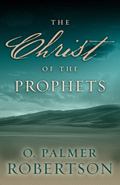
O. Palmer Robertson
Reviewed by: Bryan Estelle
The Christ of the Prophets, by O. Palmer Robertson. Published by P&R, 2004. Hardback, 553 pages, list price $29.99. Reviewed by Prof. Bryan Estelle of Westminster Seminary California.
O. Palmer Robertson has written a clear and well-researched volume on the Prophets. Since Robertson's book is updated with modern scholarship, over time it will at least supplement, if not replace, E. J. Young's My Servants the Prophets in most conservative quarters. This reviewer learned much from Robertson's new book.
The title indicates his basic orientation: the Prophets teach about the Messiah to come, namely, Christ Jesus. In fact, this is the real strength of the book: a responsible, Christocentric reading of the Prophets.
After covering introductory issues in the beginning chapters, Robertson treats the various prophets in chronological order. The two concluding chapters discuss the predictive element in prophecy and the core event of Israel's prophetic movement.
It is often declared (or rather, assumed) that many of the "prophecies" in the Prophets were written after the event actually happened. But Robertson defends the "reality of predictive prophecy in the old covenant Scriptures."
A Reformed hermeneutic of prophetic development is pervasive in the book (e.g., see the discussion of Ezekiel's vision for the temple). Should prophetic passages of promise be treated in geopolitical terms, or in some different manner? Robertson lands on the right side of this question. Although the framework of prophetic visions is cast in old covenant images, the "radical differences of the new" imply that the more literal level is being subsumed for the second level of meaning. In the Prophets, what is passing, prototypical, and provisional gives way to what is permanent, antitypical, and perfective (e.g., pp. 299-301, 307-8). In other words, first-level imagery is used to describe second-level reality. We are indebted to Robertson for stating this functional hermeneutic in fresh and clear ways.
Despite these strengths, this reviewer noted at least two weaknesses in the book. First, Robertson has essentially not changed his working definition of covenant ("bond-in-blood sovereignly administered"), propounded in his prior book, The Christ of the Covenants. That definition does not have sufficient explanatory power, in my view. The consequences are evident in this book. Second, treatments of the Mosaic covenant could have been strengthened by drawing upon a host of Reformed luminaries from the past - something noticeably missing from his book - who have explained the operation of a works principle in the Mosaic economy differently than Robertson does. Nevertheless, the author and the publisher are to be commended for producing a fine volume. The book includes a bibliography, an index of subjects and names, and an index of Scripture and ancient texts.
November 09, 2025
November 02, 2025
October 26, 2025
October 19, 2025
October 05, 2025
Raising Sexually Faithful Kids and
Parenting Boys and Girls in a Gender-Confused World
September 28, 2025
Calvin’s Ecclesiology: A Study in the History of Doctrine
September 21, 2025
© 2025 The Orthodox Presbyterian Church